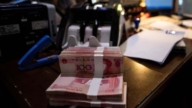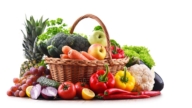【新唐人2011年2月15日讯】由于中国近期食品价格飙涨,国际投资银行高盛集团在最新的报告中预测,2011年中国一月份的消费者物价指数CPI可能达到5.3%。如果粮价持续上涨,将成为中共在2011年面临的大问题之一。
英国《金融时报》中文网的特约撰稿人白鹤鸣,在11号刊登的专栏文章中指出,这个月9号晚间,一场人造雪虽为华北带来了长达一百多天以来的第一场雪。但在长期干旱与雪量不足的情况下,干燥的土壤一搓就碎,冬小麦的麦苗长势明显不如去年。尽管已经用地下300米或400米抽上来的井水进行灌溉,仍有超过一亿亩(1.12亿亩)的耕地受损严重,这庞大损失的后果在今年六月中收成季节就会看到。
文章指出,如果粮价持续上涨,将成为中国政府在2011年面临的大问题之一。中国城镇家庭用于购买食品的支出比例,今年很可能会超过40%。而几天前让埃及穆巴拉克政府跨台的示威游行,跟官方未能在粮价上涨的情况下,提供民众足够的廉价面包有关。这等于告诉中共政府,一旦粮价失控,“维稳”将会越来越困难。
而且国际情势难以乐观。去年十月俄罗斯宣布,停止出口粮食的禁令将全面延长到今年七月一号,美国玉米产量也下降。由于中国近期食品价格飙涨,国际投资银行高盛集团在最新的报告中预测,2011年中国一月份的消费者物价指数CPI可能将达到5.3%。
面对新一代炒作民生物价的主力不是家庭主妇,而是手握庞大资金的投机客,各国政府都在思考如何增加粮食产量,但文章指出,中国大陆继续增产的空间却越来越小。去年中国粮食产量虽达到5.04亿吨,但这一切是在机械化农业和化肥催化下完成的。回顾过去几十年来,中共政府以消耗环境资源的方式实现的粮食产量,背后所付出的代价,光是水资源一项就十分惊人,河北的地下水位从十几米下降到几百米,而且还在持续下降。相较之下,美国农业为了环保,也为了食品健康,一般只用机械,少用化肥和农药,小麦亩产量虽然只有中国的三分之一,却保存了自然环境与资源。
最后,作者指出,今日农业已成为一种需要长期投资、经营的重要产业,民众需要的是能在农产歉收,或粮价大跌时填补农民损失的“农业保险制度”,但是因为保险公司赔的太多,“农业保险制度”在中国大陆已渐渐消失了。
新唐人记者曾耀贤、萧宇综合报导。
Soaring Grain Price Undermines CCP’s Efforts in Maintaining Stability
The grain price in China has been soaring recently.
Goldman Sachs Group said in its latest report that
China’s CPI in Jan. 2011 could be as high as 5.3%.
If the grain price continued to rise, it would become
one of the major challenges the regime faces in 2011.
Bai Heming, columnist for UK’s Financial Times
Chinese site, said in his article, on Feb.9, the artificial
snowfall technology induced the first snow
in North China in the past three months.
The long drought has turned the soil into powder.
The growth of winter wheat is worse than last year.
People are using underground water from
300 or 400 meters below ground to irrigate.
Still, 18.5 million acre of land suffered serious loss.
The damage will show up in the harvesting season.
The article said, if the grain price keeps on rising,
Chinese government will face some serious problems.
Food expense for urban families could exceed 40%.
The protest in Egypt that toppled Mubarak is partially
related to his failure in providing people with
enough low-price foods.
It is a sign to the Chinese government.
Once the grain price is out of control, it will be
more and more difficult to maintain stability.
The global situation is not that optimistic. Last Oct.,
Russia extended a grain-export ban to July this year.
U.S. witnesses a reduction in its maize yield.
Because food price in China is soaring,
Goldman Sachs Group said in its latest report that
China’s CPI in Jan. 2011 could be as high as 5.3%.
It is not the housewives who pushed the price high,
but the speculators with tons of money.
Every government is concerned of how to increase
grain production. The article said, there is limited
room for China to increase grain yield. Last year,
China’s grain production was 504 million ton, which
is boosted by fertilizers and mechanized agriculture.
In the past several decades, the government has been
exhausting the resources to increase grain production.
It is a heavy price paid.
Water consumption alone was stunning.
The underground water level in Hebei reduced from
10 meters to several hundred meters.
It continues going down. In contrast, the U.S. only
uses machines but not fertilizers or pesticides.
Their wheat yield is only one third that of China,
but the environment and resources are well protected.
Bai Heming said, agriculture is now an important
industry of investment and operation.
What people need is an insurance system that will
provide compensation in lean times,
or when the market price falls.
Since the insurance companies lost too much money,
the “agriculture insurance” is disappearing in China.
NTD reporters Zeng Yaoxian and Xiao Yu




























